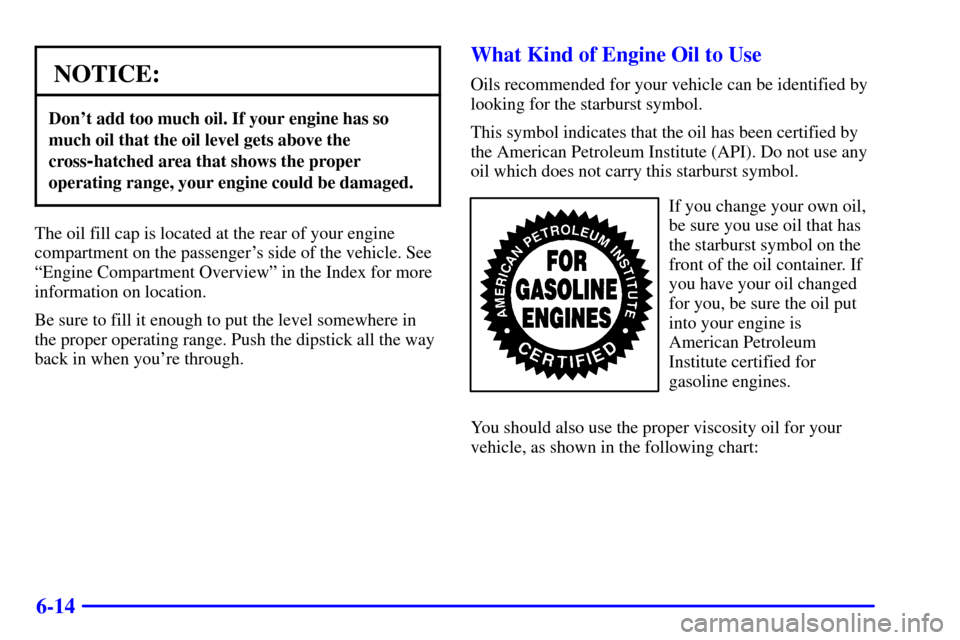Page 12 of 363
Service Station Guide
Oil Viscosity
Engine Oil
See Section 6
Cooling System
See Section 5
Hood Release
See Section 6
Windshield Washer
Fluid
See Section 6Battery
See Section 6
For
a More
Detailed Look at
What's Under the Hood
See Section 6
Tire Pressure
See Section 6
V6 Engine Oil
Dipstick
See Section 6
V8 Engine Oil
Dipstick
See Section 6
Fuel
Use unleaded only.
See Section 6
for octane ratings.
Spare Tire Pressure
See Section 5
Page 150 of 363

2-92
Emissions Inspection and Maintenance Programs
Some state/provincial and local governments have or may
begin programs to inspect the emission control equipment
on your vehicle. Failure to pass this inspection could
prevent you from getting a vehicle registration.
Here are some things you need to know in order to help
your vehicle pass an inspection:
Your vehicle will not pass this inspection if the
SERVICE ENGINE SOON or CHECK ENGINE light is
on or not working properly.
Your vehicle will not pass this inspection if the
OBD (on
-board diagnostic) system determines that
critical emission control systems have not been
completely diagnosed by the system. The vehicle would
be considered not ready for inspection. This can happen
if you have recently replaced your battery or if your
battery has run down. The diagnostic system is designed
to evaluate critical emission control systems during
normal driving. This may take several days of routine
driving. If you have done this and your vehicle still does
not pass the inspection for lack of OBD system
readiness, see your dealer or qualified service center to
prepare the vehicle for inspection.
Oil Pressure Gage
3800 V6 Engine 5.7L V8 Engine
This gage tells you if there could be a problem with
your engine oil pressure. The gage shows the engine
oil pressure in psi (pounds per square inch) or
kPa (kilopascals) when the engine is running.
On the 3800 V6 engine, the oil pressure should be
20 to 120 psi (140 to 827 kPa). On the 5.7L V8 engine,
oil pressure should be 20 to 80 psi (140 to 550 kPa). In
certain situations such as long, extended idles on hot
days, it could read as low as 6 psi (40 kPa) and still be
considered normal. It may vary with engine speed,
outside temperature and oil viscosity, but readings above
the red area show the normal operating range.
Page 268 of 363

6-14
NOTICE:
Don't add too much oil. If your engine has so
much oil that the oil level gets above the
cross
-hatched area that shows the proper
operating range, your engine could be damaged.
The oil fill cap is located at the rear of your engine
compartment on the passenger's side of the vehicle. See
ªEngine Compartment Overviewº in the Index for more
information on location.
Be sure to fill it enough to put the level somewhere in
the proper operating range. Push the dipstick all the way
back in when you're through.
What Kind of Engine Oil to Use
Oils recommended for your vehicle can be identified by
looking for the starburst symbol.
This symbol indicates that the oil has been certified by
the American Petroleum Institute (API). Do not use any
oil which does not carry this starburst symbol.
If you change your own oil,
be sure you use oil that has
the starburst symbol on the
front of the oil container. If
you have your oil changed
for you, be sure the oil put
into your engine is
American Petroleum
Institute certified for
gasoline engines.
You should also use the proper viscosity oil for your
vehicle, as shown in the following chart:
Page 269 of 363
6-15
5.7L V8 EngineAs in the chart shown previously, if you have the
5.7L V8 engine, SAE 5W
-30 is best for your vehicle.
However, you can use SAE 10W
-30 if it's going to be
0�F (
-18�C) or above. These numbers on an oil
container show its viscosity, or thickness. Do not use
other viscosity oils, such as SAE 20W
-50.
As shown in the following chart, if you have the
3800 V6 engine, SAE 10W
-30 is best for your vehicle.
However, you can use SAE 5W
-30 if it's going to be
colder than 60�F (16�C) before your next oil change.
When it's very cold, you should use SAE 5W
-30.
These numbers on an oil container show its viscosity, or
thickness. Do not use other viscosity oils, such
as SAE 20W
-50.
Page 347 of 363

7-23
Part D: Recommended Fluids
and Lubricants
NOTE: Fluids and lubricants identified below by name,
part number or specification may be obtained from
your dealer.
USAGE
FLUID/LUBRICANT
Engine OilEngine oil with the American
Petroleum Institute Certified
for Gasoline Engines starburst
symbol of the proper viscosity.
To determine the preferred
viscosity for your vehicle's engine,
see ªEngine Oilº in the Index.
Engine Coolant50/50 mixture of clean,
drinkable water and use only
GM Goodwrench
� DEX-COOL�
or Havoline� DEX-COOL�
Coolant. See ªEngine Coolantº
in the Index.
USAGEFLUID/LUBRICANT
Hydraulic
Brake SystemDelco Supreme 11� Brake Fluid
(GM Part No. 12377967 or
equivalent DOT
-3 brake fluid).
Windshield
Washer SolventGM Optikleen� Washer Solvent
(GM Part No. 1051515)
or equivalent.
Hydraulic
Clutch SystemHydraulic Clutch Fluid
(GM Part No. 12345347 or
equivalent DOT
-3 brake fluid).
Power
Steering SystemGM Power Steering Fluid
(GM Part No. 1052884
- 1 pint,
1050017
- 1 quart, or equivalent).
Manual
TransmissionDEXRON�-III Automatic
Transmission Fluid.
Automatic
TransmissionDEXRON�-III Automatic
Transmission Fluid.